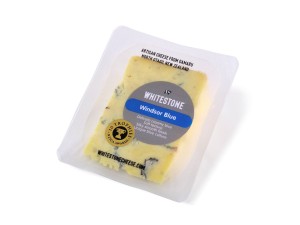Again, anyone sick? How was the Listeria detected? More Australian mysteries.
 Whitestone Cheese (NZ) has recalled Whitestone Windsor Blue Cheese 110g from Woolworths Supermarkets in QLD, NSW, ACT and VIC due to Listeria monocytogenes contamination.
Whitestone Cheese (NZ) has recalled Whitestone Windsor Blue Cheese 110g from Woolworths Supermarkets in QLD, NSW, ACT and VIC due to Listeria monocytogenes contamination.

Again, anyone sick? How was the Listeria detected? More Australian mysteries.
 Whitestone Cheese (NZ) has recalled Whitestone Windsor Blue Cheese 110g from Woolworths Supermarkets in QLD, NSW, ACT and VIC due to Listeria monocytogenes contamination.
Whitestone Cheese (NZ) has recalled Whitestone Windsor Blue Cheese 110g from Woolworths Supermarkets in QLD, NSW, ACT and VIC due to Listeria monocytogenes contamination.
Retirement homes and hospitals have a lot of trouble with norovirus. If an ill resident, patient or staff member sheds the virus through vomit or poop in a public area a lot of folks can get sick.
According to KDRV ABC Channel 12, The V.A. hospital in White City Oregon is dealing with its own norovirus outbreak with over 125 veterans and 25 staff ill.
“This is very contact oriented, it’s not airborne, it’s by touch,” said V.A. Infection Preventionist Sue Thurston.
Thurston said about 470 vets live at the V.A, and more than a quarter of them are sick.
Veterans are being asked to not leave their rooms until they feel better and bag meals are dropped off at their rooms.
“We’re wiping down everything you can touch – all the side rails, all the doorknobs, all the vending machines, all the rooms, all the surfaces, every single flat surface is being wiped down and disinfected,” said Thurston (I wonder what sanitizer they are using and wiping may just be spreading virus particles around -ben).
Although the virus isn’t respiratory, epidemiological investigations of past outbreaks suggest that virus particles can be aerosolized through vomit events. At IAFP 2013, North Carolina State University graduate student Grace Tung showed a simulated vomit event would yield a spread of droplets 8-12 ft.; the greatest distance traveled in any one experiment was 14.5 ft.
I’ve always been a Smarties type, but for some of my kids, who maybe watched the South Park movie at an impressionable age, Skittles brings them to hysterical laughter.
Not so much fun for the two people who ate from a package of contaminated Skittles required hospital treatment for burning throats, cramping and diarrhea, Indiana authorities  said Wednesday night.
said Wednesday night.
The Indiana State Department of Health said in a news release that preliminary tests showed that packages of Skittles sold at a Marathon Food Mart in Richmond had some kind of chemical substances, though what exactly those substances were has yet to be confirmed.
Investigators also don’t yet know if the package of candy was tampered with, but Indiana State Police, the Indiana Department of Homeland Security and the U.S. Food and Drug Administration have joined the investigation, Health Department spokesman Amy Reel said.
Authorities are advising people who purchased Skittles with the lot numbers 08JUL14 023 or 01DEC14 023 not to consume the candy but to place the package in an envelope, hold it in a secure location and contact Indiana State Police.
Hockey starts this weekend in Brisbane (that’s ice hockey) and I’ll be coaching and playing a little, and even brought my ice cones over from North America during my last trip (they’re called witch hats here; I can’t make this stuff up).
Apparently I have to sterilize them.
Contractors were forced to spray contaminated road cones in Mairehau, New Zealand, with disinfectant to prevent staff from getting sick.
Toilet paper and other sewage was still flowing out of a drain in the road yesterday morning.
Jim Young, of Transfield Services, said some of the cones had been floating in the flood waters. They would be hosed down with a water-blaster once he had finished spraying them.
“We don’t want our guys to get sick from touching them before they eat lunch or anything  like that,” he said.
like that,” he said.
Smith said he saw footage on television of children playing in contaminated water, during the floods, which was “not ideal”.
In Missouri, about 40 people, including nearly half the roster of a minor league hockey team, got ill at a charity event Monday night, and health officials say a nasty stomach virus is the likely culprit.
The family bowl night at Harvest Lanes was a benefit for Autism Speaks. Members of the St. Charles Chill hockey team were on hand to sign autographs, and about 36 hours later, many of the players and front-office workers developed symptoms.
Doug Bolnick, a spokesman for the St. Charles County Health Department, said officials suspect the illness is the work of the norovirus.
Food safety isn’t dogmatic, it’s based on risk, the product of the likelihood of the hazard and severity of an illness. L.V. Anderson of Slate tackles risk as it relates to raw eggs in homemade cookie dough. She makes the case that the chance of Salmonella in eggs is relatively low (1 in 20,000 eggs) and many egg-related illnesses are linked to pooled and/or temperature abused eggs (see Australia). 
Every time I have made a type of cake or cookie for the recipe column I write for Slate, I’ve unfailingly consumed some of the uncooked mixture. Heck, every time I’ve made a type of cake or cookie just for fun, I’ve unfailingly consumed some of the uncooked mixture. And I have never in my 27 years gotten salmonella poisoning.
A quick back-of-the-envelope calculation: I estimate that I’ve baked cookies, cake, or brownies once a month, on average, since I started baking by myself around the age of 12 and that I have tasted the dough or batter every time. Let’s say that each of those batches of cookies, cake, or brownies has contained two eggs—a conservative estimate. This means that I have ingested the innards of—at the very least—360 uncooked eggs in my life.
Using data from the 1990s, the Centers for Disease Control and Prevention estimate that one in 20,000 eggs is internally contaminated with salmonella. Since salmonella prevention practices have improved since then, the egg contamination rate is probably even lower now.
Speaking personally, the statistics haven’t scared me off unpasteurized eggs for good. If I continued consuming batter and dough containing about two raw eggs per month, I would likely encounter only one SE-contaminated egg over the course of 833 years. And if I remain generally healthy, I might not even get sick from that SE-contaminated egg. Of course, by the time I’m 860, my immune system will probably be weak enough that I’ll want to avoid unpasteurized eggs. In the meantime, though, I’ll take my chances on that cake batter.
That’s a pretty reasoned exposure decision – although I’m not sure severity comes into her calculation. Salmonella isn’t like norovirus where symptoms are acute but generally limited to 2-3 days. Salmonellosis can often lead to hospitalizations and in some cases reactive arthritis. Homemade cookie dough with two individual eggs also isn’t nearly the same as egg dishes at food service where a lot of pooling happens (like sauces and Caesar salad dressing). Each egg added into the mix magnifies the risk. Uncooked foods also carry other risks associated with other ingredients. A 2009 E. coli O157 outbreak linked to raw cookie dough was thought to be flour-linked (not eggs).
Anderson’s choice works for her, but the risk calculation changes with other populations like my kids (who beg to lick the bowl) because don’t have fully developed immune systems. A 1 in 20,000 chance is too much for me to handle as a parent – especially with the consequences. So we use pasteurized eggs in our recipes.
Workers and customers who handle live or raw fish or seafood from Chinatown markets in Brooklyn, Queens and Manhattan could be exposed to a bacteria that causes swelling and bumps on their hands and arms.
But the fish is safe to eat, officials added.
The department said it has identified an outbreak of a rare infection that enters the skin  through a cut or other injury.
through a cut or other injury.
Customers and workers are encouraged to wear gloves while preparing the fish, especially people with cuts or abrasions.
The bacteria causing the infection is called Mycobacterium marinum and can be treated with antibiotics. If the infection isn’t treated correctly, it can worsen over weeks and require surgery.
Thirty cases have already been identified, said Health Department spokesman Levi Fishman.
He said the fish affected come from markets in Chinatown in Manhattan, Flushing in Queens and Sunset Park in Brooklyn.
Fishmongers in Manhattan’s Chinatown said they are usually careful about how they handle their products, but they also are now telling customers to keep their hands off.
“When we clean the fish, we wear rubber gloves and we use plastic bags to take up the fish,” said Asta Mak, 26 who works in The Haisein Co. fish shop on Grand Street. “We don’t touch with our hands. We don’t let the customers touch the fish. They point at what they want and we take it up for them.”
Jacque Even, 40, a chef from the Lower East Side, cooks fish at work and buys it twice a week to make at home. He usually touches the fish before making his purchase.
“I check it out before I buy,” Even said. “I touch it to feel the quality and make sure it is clean. I open the gill to see if it’s fresh. I’m going to have to stop doing that and point at what I want.”
Anyone sick? How was the Salmonella detected? More Australian mysteries.
Energetic Greens has recalled Organic Sprouts Salad (Broccoli, sunflower and radish) from local greengrocers and IGA stores in northern NSW (New South Wales)nand the  Mullumbimby, Bangalow and Glorious Organic Farmers Markets due to Salmonella contamination. Food products contaminated with Salmonella may cause illness if consumed. Any consumers concerned about their health should seek medical advice.
Mullumbimby, Bangalow and Glorious Organic Farmers Markets due to Salmonella contamination. Food products contaminated with Salmonella may cause illness if consumed. Any consumers concerned about their health should seek medical advice.
About 150 customers were sickened with Salmonella linked to a mayonnaise served at a New Town restaurant in Brazil in early January.
One of the penalties imposed was a fine of R$ 2,650,22, which would give R$ 17.66 per  person.
person.
Mayonnaise on each site, which may have caused the intoxication, cost R$ 19.90.
The Tribune sought those responsible for the establishment, but until the time of writing, only one person answered the report, saying it was not reported and would not comment on the cause.
Wastewater used to irrigate agricultural crops in countries where water is scarce may contribute to significant public health risks such as diarrheal disease in children from rotavirus. A new study of these risks found that wastewater used to irrigate vegetable plots in Asian countries poses health risks that may exceed World Health Organization (WHO)  guidelines. The authors recommend that stricter wastewater regulation may be needed to protect the health of farmers and consumers worldwide.
guidelines. The authors recommend that stricter wastewater regulation may be needed to protect the health of farmers and consumers worldwide.
The new findings come at a time when climate change and increasing population pressure requires the development of methods to produce more food with fewer irrigation resources. Wastewater reuse is an economical method to grow food, but wastewater carries microorganisms such as viruses, bacteria and protozoa that can contaminate food and cause disease. Asia accounts for the majority of the world’s reuse of wastewater in irrigation, and given that China is the world’s most populous country, millions of people may be exposed to health risks from contamination. However, normal cooking temperatures and food preservation strategies can reduce the risks posed by microorganisms and viruses.
Although health studies can trace the incidence of disease in a population, conducting extensive experimental work and collecting sufficient data can be cost-prohibitive. Food systems researchers Hoi-Fei Mok and Andrew J. Hamilton of The University of Melbourne in Australia instead created a statistical model to characterize the health risks posed by wastewater used to grow Asian vegetables. The reach of the Asian vegetable market extends well beyond Asia. Their paper, “Exposure factors for wastewater-irrigated Asian vegetables and a probabilistic rotavirus disease burden model for their consumption,” recently appeared in the electronic version of the journal Risk Analysis, published by the Society for Risk Analysis.
The researchers first determined the volume of water retained by three commonly grown Asian vegetables, and then used a statistical model to estimate rotavirus disease burdens associated with wastewater irrigation. Rotavirus is associated with diarrheal disease in children, and was chosen as the focus of the study because diarrheal disease is associated with 74 percent of wastewater-related deaths, 90 percent of which occur in children. According to the WHO, diarrheal disease is the second leading global cause of death in children under five years old, and is responsible for the deaths of approximately  760,000 children each year. Diarrhea can last several days, and can leave the body without the water and salts that are necessary for survival. Most people who die from diarrhea actually die from severe dehydration and fluid loss.
760,000 children each year. Diarrhea can last several days, and can leave the body without the water and salts that are necessary for survival. Most people who die from diarrhea actually die from severe dehydration and fluid loss.
Based on their findings, the researchers concluded that the probability curves of the annual disease burden “exceeded the WHO’s threshold for acceptable level of risk from wastewater reuse by two to three orders of magnitude.” Some vegetables posed greater risk than others, because leaf shape affects the amount of wastewater and contaminants that are retained. Vegetables such as bok choy posed the least risk and choy sum the greatest risk, whereas lettuce and gai lan had similar risk profiles. The viral decay rate also varies depending on the plant. The authors say that more research on the rate of viral decay on various crops would increase the accuracy of risk estimations.
The probability of rotavirus infection is affected by uncertainty in virus concentration and variation in vegetable consumption. For example, the mean daily per capita lettuce consumption in Australia is 21.81 grams lettuce/person day, compared to a mean of 171.94 grams lettuce / person day in China, although there is seasonal variation in consumption patterns.
The dose-response model, which characterizes the relationship between exposure level to contaminants and the probability of developing disease, is a source of uncertainty in the risk assessment. The rotavirus infection rates were based on data from an infectivity trial in adults, but rotavirus primarily affects children. Lower doses induce infectivity in children faster than adults, so the estimated disease burdens from the researchers’ statistical model may underestimate the actual risk to children. Collecting rotavirus infectivity data for children would improve the accuracy of risk assessments of the threat.
Although there are Chinese national standards and regulations for the reuse of wastewater, they present only threshold concentrations for bacteria such as E. coli, not viruses. Furthermore, while there are regulations relating to water quality, there is no guideline for risk management around wastewater reuse in China. The risk management approach involves more pro-active identification and management of risk, rather than relying on post-treatment testing for managing reuse schemes. Considering the global increase in wastewater use for agricultural irrigation, assessing the health risks from reuse schemes is necessary to develop better wastewater management policies to protect public health.
Michael Batz (right, pretty much as shown) writes:
A friend of mine who played guitar in a punk band once told me to “always leave them wanting more.” He was talking about how some bands played for too long, leaving the  audience bored by the end. Their approach, by contrast, was to play about 15 songs in 12 minutes.
audience bored by the end. Their approach, by contrast, was to play about 15 songs in 12 minutes.
Sometimes it made people a little angry.
I guess I learned a lesson from him, since it took my colleagues and I 10 years to publish the results of our foodborne illness risk ranking work in a pair of journal articles in 2012. Or maybe I’m just lazy. In any case, as much as we tried to get it all in there, we definitely left folks wanting more. Which is to say, we got a lot of questions about the details. And I guess that’s half the point of these things, right? So we decided to go further into the weeds.Three papers in 12 years? Pretty punk rock. Or lazy. Whatever.
US: Disease-outcome trees, EQ-5d scores, and estimated annual losses of quality-adjusted life years (QALYs) for 14 foodborne pathogens in the United States
3.Mar.14
Foodborne Pathogens and Disease doi:10.1089/fpd.2013.1658
Michael Batz, Sandra Hoffmann, and J. Glenn Morris Jr
http://online.liebertpub.com/doi/abs/10.1089/fpd.2013.1658
Measures of disease burden such as quality-adjusted life years (QALYs) are increasingly important to risk-based food safety policy. They provide a means of comparing relative risk from diverse health outcomes. We present detailed disease-outcome trees and EQ-5D scoring for 14 major foodborne pathogens representing over 95% of foodborne illnesses, hospitalizations, and deaths due to specified agents in the United States (Campylobacter spp., Clostridium perfringens, Cryptosporidium parvum, Cyclospora cayetanensis,  Escherichia coli O157:H7, Shiga toxin–producing E. coli non-O157, Listeria monocytogenes, nontyphoidal Salmonella enterica, Shigella, Toxoplasma gondii, Vibrio vulnificus, Vibrio parahaemolyticus and other noncholera Vibrio, and Yersinia enterocolitica). We estimate over 5800 QALYs lost per 1000 cases of L. monocytogenes and V. vulnificus, compared to 125 QALYs lost per 1000 cases of T. gondii, 26 for E. coli O157:H7, 16 for Salmonella and Campylobacter, and 14 for Y. enterocolitica. The remaining 7 pathogens are estimated to cause less than 5 QALYs lost per 1000 cases. In total, these 14 pathogens cause over 61,000 in QALY loss annually, with more than 90% due solely to acute infection being responsible for 65% of total QALY loss, with premature mortality and morbidity due to chronic and congenital illness responsible for another 28%. These estimates of the burden of chronic sequelae are likely conservative; additional epidemiological research is needed to support more accurate burden estimates. This study shows the value of using integrated metrics for comparing disease burden, and the need to consider chronic and congenital illness when prioritizing foodborne pathogens.
Escherichia coli O157:H7, Shiga toxin–producing E. coli non-O157, Listeria monocytogenes, nontyphoidal Salmonella enterica, Shigella, Toxoplasma gondii, Vibrio vulnificus, Vibrio parahaemolyticus and other noncholera Vibrio, and Yersinia enterocolitica). We estimate over 5800 QALYs lost per 1000 cases of L. monocytogenes and V. vulnificus, compared to 125 QALYs lost per 1000 cases of T. gondii, 26 for E. coli O157:H7, 16 for Salmonella and Campylobacter, and 14 for Y. enterocolitica. The remaining 7 pathogens are estimated to cause less than 5 QALYs lost per 1000 cases. In total, these 14 pathogens cause over 61,000 in QALY loss annually, with more than 90% due solely to acute infection being responsible for 65% of total QALY loss, with premature mortality and morbidity due to chronic and congenital illness responsible for another 28%. These estimates of the burden of chronic sequelae are likely conservative; additional epidemiological research is needed to support more accurate burden estimates. This study shows the value of using integrated metrics for comparing disease burden, and the need to consider chronic and congenital illness when prioritizing foodborne pathogens.